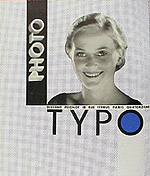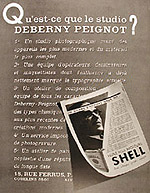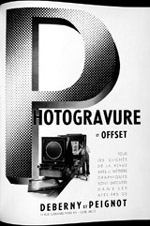III: AMG Staff, Contributors, and Audience
Charles Peignot first published Arts et Métiers Graphiques in 1927. To do this, he assembled an editorial staff made up of men from his father's generation and peers from his own. In this way AMG sprung from a perfect balance of time-tested experience and forward-thinking enthusiasm. Each member's expertise served a specific purpose. From the old guard, Peignot collaborated with Henri-Albert Motti, director of Imprimerie de Vaugirard that printed AMG through its final issue in 1939. Also Léon Pichon, an editor, printer, and type designer, and Walter Maas, advertising executive, worked on the director's committee. Lucien Vogel, prolific publisher of three other monthlies, Gazette du Bonton, Jardin des Modes, and Vu, advised on the magazine's audience appeal. Rounding out this group was François Haab, who served as the editor-in-chief for over 40 issues. From Peignot's generation was Bertrand Guégan who contributed to most every issue, first as the "Book History and Bibliophile" columnist, then as a regular book reviewer. After Guégan's resignation as a full-time staffer in 1932, Jean Bruller covered the "Bibliophile" column. In 1934, André Lejard and Henri Jonquières joined as editor and artistic director, respectively. Although not an official staff-member, Maximilien Vox published regularly on typography design through all ten years of the magazine's publication. With this host of talent, Peignot could realize his "most interesting and luxurious [art magazine] in the world."[4]
In addition to the regular staff, contributors to AMG were all members of that privileged and educated class who supported the production of deluxe books. The AMG writers' elite included editors of contemporary art magazines such as Thadée Natanson[5] from La Revue Blanche, and André Billy[6] from Les Soirées de Paris. Typographic historians and aesthetes such as Marius Audin[7] and Stanley Morrison[8] also joined this group. Celebrated engravers and lithographers, including Galanis[9] and Daragnès,[10] shed light on their creative process by publishing in AMG. The magazine sought the contributions of graphic artists such as Cassandre,[11] Carlu,[12] Brodovitch,[13] and Tschichold[14] to provide commentary on their profession. Finally, writers from the most important contemporary French literary movements were all represented in AMG. Symbolist poems from Paul Valéry[15] and Léon-Paul Fargue,[16] Surrealist works by Jean Cocteau[17] and Paul Eluard,[18] the fantasies of Apollinaire,[19] and writings by novelists Henry de Montherlant,[20] and André Malraux[21] were all featured on the magazine's pages.
Writings by world-class contributors were also accompanied by images from world-class photographers. AMG's coverage of artistic photographic trends formally began with the publication of the 1930 Photography special issue, (AMG 16). Before then, Charles Peignot had only tapped into photography's value as a graphic arts service. In 1927 he established the Studio Deberny-Peignot which offered studio photography and made photogravure plates. Both functions complemented his typesetting business (figs. 74-76).[22]
Photographie 1930 was popular with readers. In it, photographs from every genre—Bauhaus modernism, abstraction, Contructivism, scientific imaging, advertising photography—were reproduced together in velvety photogravure reproductions. The photographers whose work was represented in Photographie 1930 included, Laszlo Moholy-Nagy, Edward Steichen, André Kertèsz, Herbert Bayer, Man Ray, Germaine Krull, and BrassaÏ—all those who are considered today as masters of the art. The popularity of Photographie 1930 enabled Peignot to publish a separate photography annual almost every subsequent year until 1939. However, articles on photography were still commonly featured in AMG, evident in articles about photograms[23] or photo exhibitions.[24] Peignot also sought to attract more readers by publishing in 1934, Photocinégraphie, a low-priced magazine targeted to amateur photographers and cineastes.[25]
The attention to detail on all production fronts—design, typography, writing, photography, and printing—was intended to serve the interests of the French intelligentsia who were the connoisseurs of deluxe publications. (After all, AMG in itself could also fall into that category.) Trade printers certainly found AMG to be too lofty, and instead typically subscribed to the technical journal, Bulletin de Maîtres Imprimeurs.
The concept of the deluxe publication was so critical to AMG's editorial scope because in each publication of its caliber it was necessary to collaborate across the lines of the graphic arts. In these books, typography served subject matter, illustration was inspired by theme, and the printing and binding processes contributed to the preciousness of a singular work whose production required a writer, designer, illustrator, typographer, printer, and binder.
Noting the success of Arts et Métiers Graphiques, the receptivity of its audience, and seizing upon the creative spirit of the period, Charles Peignot took the concept of deluxe books and AMG to the next level. Under the aegis of his magazine's imprint, Peignot began to publish limited-edition books in 1930. From then until 1939, Arts et Métiers Graphiques the publisher released forty-six books, exclusive of the magazine. It was an ideal situation because the two AMG branches served one another. The magazine would publish an introductory article on a certain subject to gauge the interest of the audience. Then, after publication of a book on that subject, the magazine would review it or run an advertisement for the book. This kind of hand-shaking can be seen through publication of a 1933 article on BrassaÏ's Parisian night photography that coincided with the release of a monograph on his work. Capitalizing on the theme, Arts et Métiers Graphiques then produced another night-photo book that depicted London through the photographs of Bill Brandt.[26, 27] (See Appendix D: "Arts et Métiers Graphiques Publications in the 1930s.")
The Arts et Métiers Graphiques publishing company enjoyed greater longevity than the magazine that started it. Even though the graphic arts periodical was not sustainable after the war, the audience that read it could still be sated by occaisional arts publications. Charles Peignot directed AMG publications until 1955. Jean O'Meara then took over and was head until 1974. Jacques Rivière ran AMG until the company's close in 1982.[28]
Figures



Appendix
Thesis: https://scholarworks.rit.edu/theses/626/
Page Notes
4 Helene Dufour, "Arts et Métiers Graphiques 1927-1939," Arts et Métiers du Livre 188 (November-December 1994), 4-5.
5 Thadée Natanson, "L'Écriture de Léon Blum, Essai de Graphologie," Arts et Métiers Graphiques, 58 (15 July 1937), 41-45.
6 André Billy, "Typographie de l'Avenir," Arts et Métiers Graphiques Paris, 9 (15 January 1929), 527-536.
7 Marius Audin, "Trente Ans de Typographie Allemande: L'Oeuvre de Rudolf Weiss," Arts et Métiers Graphiques Paris, 1 (15 September 1927), 33-37.
8 Stanley Morrison, "Non-Stop," Arts et Métiers Graphiqus Paris, 23 (15 May 1931), 225-301.
9 Démétrius Emmanuel Galanis, "L'Art de Graver en Bois Debout," Arts et Métiers Graphiques Paris, 11 (15 May 1929), 682-688.
10 Jean-Gabriel Daragnès, "Les Bois Gravés de Paul Gauguin," Arts et Métiers Graphiques, 49 (15 October 1935), 35-43.
11 A.-M. Cassandre, "Bifur: Caractère de Publicité Dessiné par A. M. Cassandre," Arts et Métiers Graphiques Paris 9 (15 January 1929), 578.
12 Jean Carlu, "Réflexions du l'Esthetique de l'Affiche," Arts et Métiers Graphiques Paris 7 (15 September 1928), 436-439.
13 Alexey Brodovitch, designer, "Graphismes," Arts et Métiers Graphiques Paris 11 (15 May 1929), 645-652.
14 Jan Tschichold, "Qu'est-ce que la Nouvelle Typographie et Que Veut-Elle?" Arts et Métiers Graphiques Paris 19 (15 September 1930), 46-53.
15 Paul Valéry, "Les Deux Vertus d'un Livre," Arts et Métiers Graphiques Paris, 1 (15 September 1927), 3-8.
16 Léon-Paul Fargue "Marées," Arts et Métiers Graphiques, 40 (15 March 1934), 5-8.
17 Jean Cocteau, "Éloge de l'Imprimerie," Arts et Métiers Graphiques Paris, 7 (15 September 1938), 5-13.
18 Paul Éluard, "Le Front Couvert," Arts et Métiers Graphiques, 52 (15 April 1936), 5-9.
19 André Rouveyre, "Le Culte de Guillaume Apollinaire," Arts et Métiers Graphiques Paris 17 (15 May 1930), 1-9.
20 Henry de Montherlant, "Mariette Lydis" Arts et Métiers Graphiques Paris, 20 (15 November 1930), 81-90.
21 André Malraux, "Un Graveur de 8 Ans: J.J.J. Rigal," Arts et Métiers Graphiques, 43 (15 October 1934), 32-37.
22 Dufour, 16.
23 René Zuber, "Photogrammes," Arts et Métiers Graphiques, 46 (15 April 1935), 34-36.
24 Emmanuel Sougez, "2 Femmes, 80 Hommes," Arts et Métiers Graphiques, 48 (15 August 1935), 40-47.
25 "Nous avons entrpris l'édition d'une nouvelle revue: 'Photo-Ciné-Graphie,'" Arts et Métiers Graphiques Paris, 40 (15 March 1934), 2.
26 Brassaï, "Technique de la Photographie de Nuit à propos de l'Album 'Paris de Nuit,'" Arts et Métiers Graphiques Paris, 33 (15 January 1933), 24-28.
27 Bill Brandt, Londres de Nuit: Soixante-Quatre Photographies, Paris: Arts et Métiers Graphiques, 1938.
28 Dufour, 17.